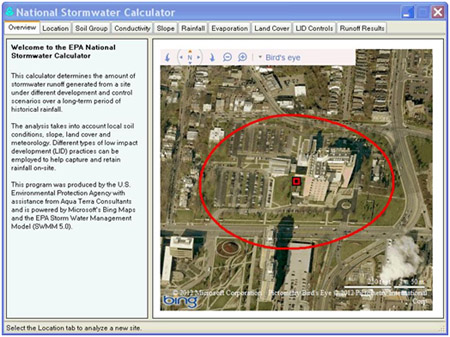
Stormwater Calculator to Manage Rainfall Runoff
A new tool developed by EPA allows planners and property owners to assess how green infrastructure can be used to reduce rainwater runoff from development sites

A screen shot of the Stormwater Calculator
How is a parking lot like a rain garden? Well, the answer is: it’s not. During heavy rains, a parking lot floods streets and sewers while a rain garden soaks it in--reducing the amount of water entering the sewage system. How about planting a rain garden inside a parking lot? Perhaps that will help curb stormwater runoff.
In Summer 2013, EPA released a new tool called the National Stormwater Calculator (SWC) to help city planners, developers, and property owners confront these types of scenarios. The tool will help decision-makers balance land development decisions with green infrastructure practices--incorporating features such rain gardens, rain barrels, cisterns and natural areas that absorb rainwater-- to prevent problems associated with urban stormwater runoff.
Urban stormwater is a major source of impairment for rivers, lakes, coastal shorelines, and other water resources in the Nation. It is also responsible for flooding, combined sewer overflows which route both sewage and stormwater into common networks of pipes and tend to overflow during heavy rainfall, and reduced groundwater recharge. Incorporating green infrastructure into new development is one way to combat these stormwater issues.
The easy-to-use SWC will estimate the annual amount and frequency of stormwater runoff from a specific site based on local soil conditions, land cover, and historical rainfall records. Users can input any location within the U.S. and select different development and green infrastructure scenarios to see how those changes affect runoff volumes from that location.
The calculator accesses several national databases to provide local soil and weather conditions for the chosen site. The user supplies information about the site’s land cover as well as what types of green infrastructure they would like to deploy. The latter refers to such low impact controls as rain gardens, cisterns, and porous pavement that retain rainfall on site until it eventually evaporates, infiltrates, or is otherwise consumed.
As an example of how the calculator might be used, consider a developer or municipality building a parking lot on what is currently vacant land. When the developer or municipality uses the Calculator for the location and adds a parking lot, they may find that runoff volumes greatly increase, perhaps even exceeding local ordinances. They may then decide to add green spaces and rain gardens to the lot or use porous pavement. Running this scenario through the Calculator may reveal that runoff volumes are reduced with those changes, meeting local standards.
The calculator is phase I of the Stormwater Calculator and Climate Assessment Tool package announced in the President’s Climate Action Plan in June, 2013. An update to the Stormwater Calculator, which will include the ability to link to several future climate scenarios, will be released by the end of 2013. Climate projections indicate that heavy precipitation events are very likely to become more frequent as the climate changes.
Learn More
Why Study Green Infrastructure?
National Stormwater Calculator
Storm Water Management Model (SWMM)
Virtual Climate Resilience Toolkit (PDF) (2 pp, 232K)
